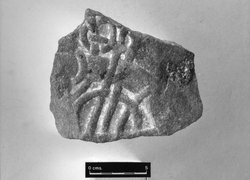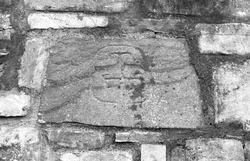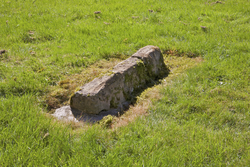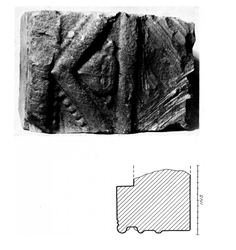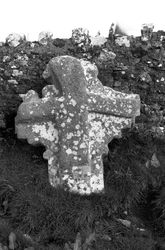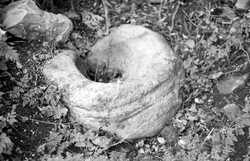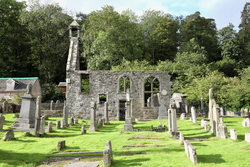
The Corpus of ROMANESQUE SCULPTURE in Britain & Ireland

Graveyard
Graveyard
The fragment was found in 1989 lying loose on the ground of the ancient graveyard.
Graveyard
A number of early cross inscribed slabs and architectural fragments from various periods built into the wall of the modern graveyard.
Graveyard
In 1606 or 1612 the parishes of Crailing and Nisbet were united and the church at Crailing was appointed to serve both. In 1622 the property and lands which had belonged to the canons of Jedburgh were made into a temporal lordship and given to Sir Andrew Ker. In 1642 Lady Anna Ker, countess of Lothian, was retoured of the tithes of the church of Nisbet and other churches ‘Quae sunt ecclesiae antiquae abbatiae de Jedburgh’. The church at Nisbet was demolished about 1757 and by 1792 there was no vestige left of the building. The churchyard, however, continued in use. In 1905, two coped grave covers were described as being in the churchyard. At that time, it was documented that there were two supports for the tegulated hogback grave cover, one of which was decorated with chevron. This large grave cover had apparently been discovered in 1890 when the churchyard was levelled. In 1944 it was still entire and located at the southern end of the churchyard, but some years later it disappeared and was found broken into 16 pieces lying in a ditch around the churchyard. It has subsequently put back together and is now in the Museum at Hawick. A cross head also existed and was photographed in 1905. The present location of the chevroned stone and cross head is not known.
Graveyard
A loose jambstone was found in the graveyard of the 15thc. church in Killyleagh. It was discovered by Dudley Waterman in the late 1960s following clearance of the graveyard. Although the jambstone was placed in storage at the time, its current location is unknown. Waterman published a brief report on the jambstone in 1971, including a drawing and photograph (Waterman 1971). A cross-inscribed stone is the only other indication of an early Christian settlement at Killyleagh. An image and diagram of the jambstone is found in Waterman's article, and reproduced here with the kind permission of the Ulster Archaeological Society.
Graveyard
Cross head leaning against the W wall of the old graveyard.
Graveyard
The remnants of two or possibly three ruined churches survive within the local graveyard. No Romanesque sculpture survives on site, but recorded drawings indicate that there were Romanesque fragments here formerly.
Graveyard
It has long been held that the old church at Logie was dedicated to St Serf, but there is no clear evidence for the dedication. In 1683, the church had become 'very ruinous' (Logie, A Parish History, I, 125), so substantial works on both the interior and exterior of the church were undertaken. 'The presbytrie met on March, 1686, thereafter for dividing of the church lately rebuilt there' (Logie, A Parish History, I, 132). Further repairs were made in the 18thc. In 1762 a group of dissatisfied parishioners established a new church, which they built at Blair Logie, a few miles away. By the early 19thc, it was decided that the fabric of the old church of Logie was irreparable, and a replacement church for it was built in 1805, less than half a mile away. The graveyard of the old church continued to be used. The ruins of the church survive. Following a meeting in late 1870, the old churchyard was ‘adjusted’ and ‘improved’ (Logie, A Parish History, I, 303). SE of the church is an intact medieval grave monument, likely to be of Romanesque date. Another grave stone is also known to have existed. This may now be represented by the row of somewhat jumbled stones lying north-south nearby.
